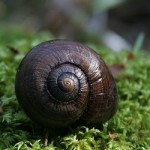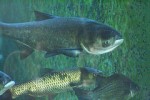Giant Carnivorous Hermaphrodite Snails

“Powelliphanta are one of our most amazing native invertebrates,” DOC ranger Mark Melville told The Dominion Post. “They are carnivores, giants of the snail world. They can live up to 20 years and they lay eggs that look like small birds’ eggs.”The species has been victim to endangered habitat and natural enemies, but the conservation efforts in areas like Hawke’s Bay are proving beneficial.
The snails dwell on damp forest floors and forage for food at night. They mainly prey on earthworms but are also known to eat slugs, using a row of sharp, backward-facing teeth to grab their prey before devouring it using digestive enzymes.
Like some other land and freshwater snail species, powelliphanta snails are hermaphrodites. This means that any adult can mate with any other adult because both female and male sexual organs are present in each snail.
Also:
Making the Best of Invasive Species

Take the Asian carp (please!). Imported from China in 1973 to clean algae from Southern ponds, the carp soon broke from their confines and infested Mississippi River waterways. Gobbling up the phytoplankton that support native species, the carp can grow four feet long and weigh 100 pounds. They continue to swim north and could establish themselves in the Great Lakes, the world’s largest freshwater system, and decimate native fish populations there.Smithsonian looks at several programs designed to get people to consume more invasive species as a way to either control them or make the best of a bad situation.
Wildlife managers have tried to prevent Asian carp and other invasive species from reaching the Great Lakes by installing electric underwater fences and, occasionally, poisoning the water. But chefs from New Orleans to Chicago have also tried to put a dent in the population by putting the fish on their menu. Now, a researcher at the Aquaculture Research Center at Kentucky State University is trying to figure out how to harvest and promote carp as a food source. Currently, a few processing plants are converting Asian carp into ingredients for fertilizer or pet food. “That’s a shame, because the meat quality is excellent,” says Siddhartha Disgupta, an associate professor at the center.
Disgupta argues that the carp has all the health benefits associated with eating fish and, since it eats low on the food chain, has few contaminants such as mercury that tend to be concentrated in the flesh of other fish species. He says he’s eaten Asian carp in various preparations and found it delicious.

No comments:
Post a Comment